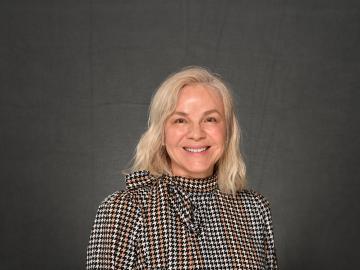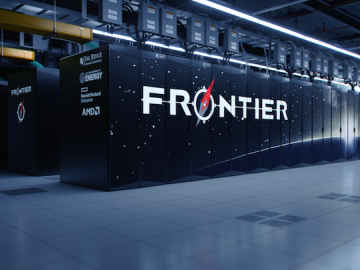
Filter News
Area of Research
- (-) Fusion and Fission (54)
- (-) Materials (433)
- (-) National Security (79)
- (-) Supercomputing (311)
- Advanced Manufacturing (34)
- Biological Systems (18)
- Biology and Environment (177)
- Biology and Soft Matter (5)
- Building Technologies (12)
- Chemical and Engineering Materials (4)
- Chemistry and Physics at Interfaces (11)
- Clean Energy (522)
- Climate and Environmental Systems (14)
- Computational Biology (6)
- Computational Chemistry (5)
- Computational Engineering (5)
- Computer Science (19)
- Data (1)
- Earth Sciences (1)
- Electricity and Smart Grid (3)
- Energy Frontier Research Centers (14)
- Energy Sciences (5)
- Fossil Energy (3)
- Fuel Cycle Science and Technology (3)
- Functional Materials for Energy (16)
- Fusion Energy (17)
- Geographic Information Science and Technology (3)
- Isotope Development and Production (3)
- Isotopes (35)
- Materials Characterization (2)
- Materials for Computing (36)
- Materials Synthesis from Atoms to Systems (13)
- Materials Under Extremes (12)
- Mathematics (1)
- Neutron Data Analysis and Visualization (4)
- Neutron Science (190)
- Nuclear Science and Technology (74)
- Nuclear Systems Modeling, Simulation and Validation (3)
- Nuclear Systems Technology (1)
- Quantum Condensed Matter (4)
- Quantum information Science (9)
- Reactor Technology (1)
- Renewable Energy (4)
- Sensors and Controls (5)
- Transportation Systems (11)
News Type
News Topics
- 3-D Printing/Advanced Manufacturing (30)
- Advanced Reactors (12)
- Artificial Intelligence (47)
- Big Data (22)
- Bioenergy (20)
- Biology (18)
- Biomedical (23)
- Biotechnology (3)
- Buildings (8)
- Chemical Sciences (34)
- Clean Water (3)
- Climate Change (24)
- Composites (9)
- Computer Science (107)
- Coronavirus (19)
- Critical Materials (15)
- Cybersecurity (23)
- Decarbonization (14)
- Energy Storage (38)
- Environment (39)
- Exascale Computing (23)
- Fossil Energy (1)
- Frontier (29)
- Fusion (29)
- Grid (16)
- High-Performance Computing (43)
- Irradiation (1)
- Isotopes (14)
- ITER (6)
- Machine Learning (23)
- Materials (81)
- Materials Science (84)
- Mathematics (1)
- Microscopy (29)
- Molten Salt (3)
- Nanotechnology (42)
- National Security (35)
- Net Zero (3)
- Neutron Science (44)
- Nuclear Energy (50)
- Partnerships (16)
- Physics (35)
- Polymers (18)
- Quantum Computing (20)
- Quantum Science (33)
- Renewable Energy (1)
- Security (14)
- Simulation (17)
- Software (1)
- Space Exploration (5)
- Summit (42)
- Sustainable Energy (24)
- Transformational Challenge Reactor (3)
- Transportation (23)
Media Contacts

ORNL is leading three research collaborations with fusion industry partners through the Innovation Network for FUSion Energy, or INFUSE, program that will focus on resolving technical challenges and developing innovative solutions to make practical fusion energy a reality.

Researchers from institutions including ORNL have created a new method for statistically analyzing climate models that projects future conditions with more fidelity.

Digital twins are exactly what they sound like: virtual models of physical reality that continuously update to reflect changes in the real world.

Hilda Klasky, a research scientist in ORNL’s Computing and Computational Sciences Directorate, has been named a fellow of the American Medical Informatics Association.

ORNL is home to the world's fastest exascale supercomputer, Frontier, which was built in part to facilitate energy-efficient and scalable AI-based algorithms and simulations.

Caldera Holding, the owner and developer of Missouri’s Pea Ridge iron mine, has entered a nonexclusive research and development licensing agreement with ORNL to apply a membrane solvent extraction technique, or MSX, developed by ORNL researchers to mined ores.

ORNL has joined a global consortium of scientists from federal laboratories, research institutes, academia and industry to address the challenges of building large-scale artificial intelligence systems and advancing trustworthy and reliable AI for

Guided by machine learning, chemists at ORNL designed a record-setting carbonaceous supercapacitor material that stores four times more energy than the best commercial material.

Scientists at ORNL used their knowledge of complex ecosystem processes, energy systems, human dynamics, computational science and Earth-scale modeling to inform the nation’s latest National Climate Assessment, which draws attention to vulnerabilities and resilience opportunities in every region of the country.

How the Frontier team broke the exascale barrier to launch a new supercomputing era for scientific discovery.


